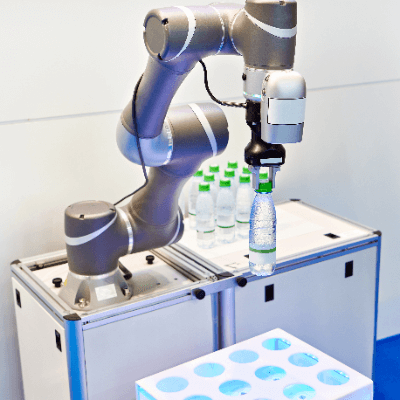What Is a Collaborative Robot?
 Collaborative robots are robots that allow humans and robots to work in the same work area.
Collaborative robots are robots that allow humans and robots to work in the same work area.
Conventional robots are mainly industrial robots that perform assembly and transportation at manufacturing sites for automobiles, for example, but they are installed in dedicated automation lines, and human access is limited to maintenance.
While such dedicated automation lines can dramatically improve productivity compared to manual operations, they tend to require a large initial investment, including design, and are less flexible compared to manual operations in case of minor problems or changes in production items.
In this situation, deregulation in 2013 made it possible to introduce collaborative robots, which work side-by-side with humans. Collaborative robots can work in the same work area as humans without safety barriers, thus helping to alleviate labor shortages. Compared to conventional dedicated automation lines, the initial investment can be reduced and additional robots can be introduced without stopping the operation of the line, making it easier for small and medium-sized companies to adopt these robots.
Currently, cooperative robots are used in a variety of manufacturing sites, including food, automobiles, and electronic components, and catering robots have also been developed and are increasingly seen in our daily lives.
Uses of Collaborative Robots
Collaborative robots are relatively small and can perform detailed work in a small workspace. Since they are generally equipped with cameras and image processing capabilities, they are used in a wide range of industries.
In particular, until now, parts have been manually inserted and supplied to the line with their orientation, position, etc. set, but with the acquisition of image processing capability, robots are now able to determine the color, shape, orientation, etc., of large numbers of parts, pick them, and supply them to the next process, making a significant contribution to productivity improvement.
Principle of Collaborative Robots
Collaborative robots are more flexible than conventional industrial robots, with 5-axis and 6-axis joints, and are capable of high-speed, high-precision work. Equipped with cameras and sensors, they can recognize not only objects but also the surrounding environment through image processing. Some models are equipped with buttons attached to the arm to control the robot’s movement instructions.
In addition, safety measures are taken to ensure that they work cooperatively in the same work area as humans. Many collaborative robots are rounded in shape to prevent injury to humans, and most of them have sensors that detect and stop operation when touched by a human.
Some robots are equipped with LED lights on the robot arm, for example, to indicate the robot’s status so that the operator can check the robot’s operation. Although the robots are designed with safety in mind, it is necessary to ensure safety through risk assessments by the companies that introduce the robots themselves.
Other Information on Collaborative Robots
When introducing a robot, whether it is an industrial robot or a collaborative robot, teaching is required to define the work operation and set the robot’s control system. There are several teaching methods as follows.
1. Off-Line Teaching
Off-line teaching involves creating a program and installing it on the robot. Although it is possible to create a program if a PC is available, it is not created while checking the actual operation and environment, and there is a possibility of programming errors, making it more difficult to program complex movements or cases where multiple robots are working simultaneously. In response to this, the digital twin technology is being applied to reproduce realistic motions.
2. Online Teaching
Online teaching is a method to configure a program based on the robot’s operation history while operating the remote control at the actual site. Since various cases are assumed and implemented on the actual site, it is necessary to stop operation during this time.
3. Direct Teaching
In direct teaching, a person directly moves the robot by hand to make the robot learn the operation. The robot arm has a built-in force sensor, torque sensor, or servo motor capable of torque detection. This method automatically calculates the externally applied force, speed, and angle of rotation to compose a program, and is often used in collaborative robots in particular.
4. Teaching Using AI
In recent years, technologies have been developed that utilize AI to create programs automatically by providing only work targets, making it possible to create work programs easily and in a short time.